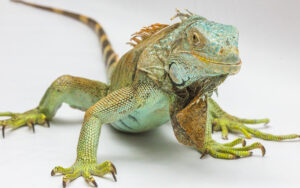Reptiles are fascinating, low-allergen pets that can live long, healthy lives with the right care—and that includes knowing how to handle them safely and respectfully. Whether you’re bonding with a friendly bearded dragon or managing a more aloof snake, proper handling is essential for both your safety and your reptile’s well-being.
In this guide, we’ll walk through the key facts and best practices for handling reptiles, from understanding their body language to ensuring your hands are reptile-ready.

1. Know Your Reptile’s Temperament
Not all reptiles enjoy or even tolerate being handled—and that’s okay! Understanding your specific species’ natural behavior will go a long way in setting realistic expectations.
Common Temperament Traits by Species:
- Bearded Dragons – Generally social and tolerant of handling
- Leopard Geckos – Usually docile but shy; may take time to adjust
- Ball Pythons – Calm and slow-moving, often easy to handle
- Green Iguanas – Can become tame, but often territorial and difficult for beginners
- Chameleons – Stress easily and are best observed rather than handled
Pro tip: Research your specific species before attempting handling, and always go slow with new reptiles.
2. Wash Your Hands—Before and After
Clean hands are a must when handling reptiles. Not only does it protect your pet from harmful substances on your skin (like soap residue, oils, or chemicals), but it also protects you from potential pathogens like Salmonella, which many reptiles naturally carry.
Always:
- Wash with unscented soap and rinse thoroughly before handling
- Wash again after handling or cleaning enclosures
- Keep hand sanitizer nearby if water access is limited, but don’t rely on it alone
3. Wait Until After Feeding
Never handle a reptile immediately after it eats. Doing so can cause stress, lead to regurgitation (especially in snakes), or even impact digestion.
General Rule of Thumb:
- Snakes: Wait at least 48 hours after a meal
- Lizards and geckos: Wait 1–2 hours
- Turtles and tortoises: Less sensitive, but still allow some digestion time

4. Timing Matters
Reptiles are cold-blooded and rely on external heat sources to regulate their body temperature. If your pet just came out of a cooler part of its tank, it might be sluggish—or cranky.
✅ Handle them when they’re warmed up and active
⛔ Avoid handling during brumation or shedding if they seem irritable
5. Stay Calm and Confident
Reptiles pick up on your energy. If you’re jumpy or nervous, they’re more likely to feel threatened or try to escape. Approach with a calm demeanor and make slow, deliberate movements.
Handling Tips:
- Support the full body (especially for snakes and lizards)
- Avoid gripping tightly—gentle restraint is key
- Never grab by the tail (some species can drop their tails in defense)
- Keep handling sessions short at first (5–10 minutes)
6. Know When Not to Handle
Sometimes the best thing you can do is give your reptile space. Avoid handling when your reptile is:
- New to your home and still acclimating
- Shedding, as they may be uncomfortable or irritable
- Sick or injured
- In brumation (a reptilian version of hibernation)

7. Use Proper Tools When Necessary
While most daily interactions can be done by hand, certain tools can help with safer handling, especially if you’re working with nervous or defensive reptiles.
Helpful Tools:
- Snake hook or tongs – For large or defensive snakes
- Towels – To create a barrier between hands and claws
- Gloves – For species with sharp claws or if you’re concerned about bites
8. Supervise Kids and Guests
Reptiles aren’t toys. If children or visitors want to interact, make sure they:
- Understand the importance of gentle, calm handling
- Are supervised at all times
- Wash hands before and after
- Don’t poke, prod, or wave their hands suddenly
9. Prepare a Safe Environment
Before you even think about picking up your reptile, make sure the room is safe:
- Close doors and windows (no unexpected escapes!)
- Remove other pets (especially cats or dogs)
- Have a clear surface or safe area to sit or stand
- Avoid high or unstable areas where a reptile could fall
10. Recognize Signs of Stress
Knowing when your reptile is not enjoying the interaction is just as important as knowing how to pick them up.
Common Stress Signals:
- Hissing or tail whipping
- Rapid escape attempts
- Puffing up or gaping mouth
- Color changes (e.g., darkening in bearded dragons)
- Excessive stillness or freezing
If you see any of these, gently return them to their enclosure and try again another day.

Bonus: Make Handling Positive
Just like dogs can be trained to like baths (okay, some dogs), reptiles can learn to tolerate or even enjoy gentle handling over time.
How to build trust:
- Be consistent with short, positive sessions
- Offer treats during or after (especially for food-motivated lizards)
- Let them come to you in the enclosure first
- Use your voice—they might not understand your words, but your tone matters
Final Thoughts
Handling reptiles isn’t just about picking them up—it’s about building trust and ensuring their safety and comfort. With the right approach, patience, and a little practice, you can help your cold-blooded buddy feel right at home in your hands.
Remember: not all reptiles are cuddle bugs, and that’s perfectly fine. Respect their boundaries, observe their body language, and always prioritize their health and stress levels.
✅ Quick Recap:
- Know your species’ temperament
- Wash hands before and after
- Avoid handling after meals or during shedding
- Stay calm and move slowly
- Use tools when needed, especially for snakes
- Respect stress signals and boundaries
- Keep kids and guests informed
- Practice builds trust—be patient
